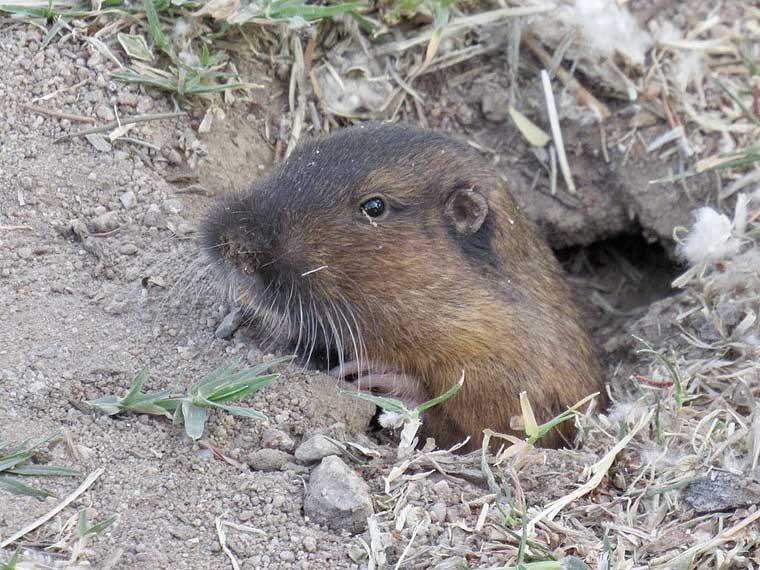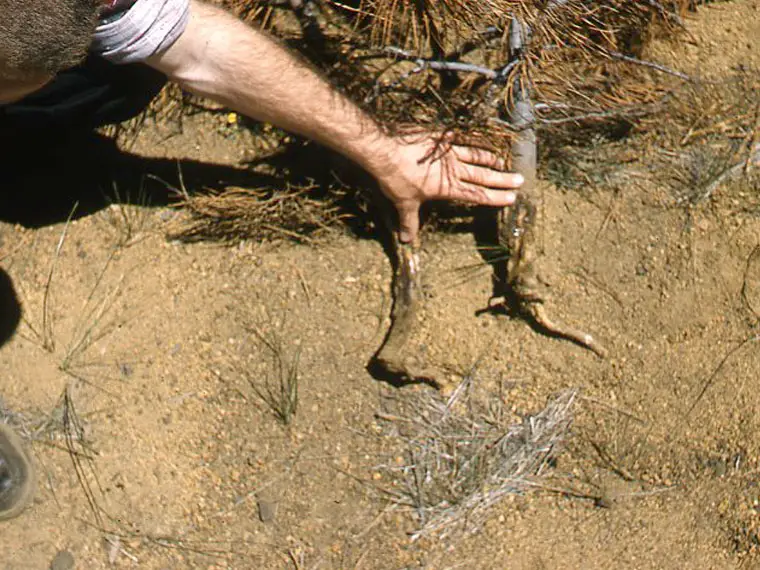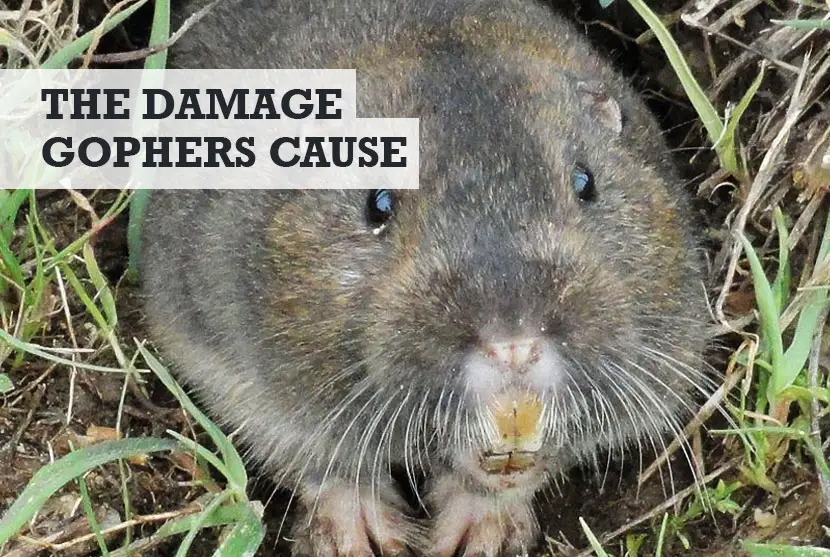Gophers live throughout North America meaning every home and yard it at risk from the damage they can wreak. Whether it’s a ruined lawn, holes in backyard, dead plants, or potential gopher damage to the foundations of you home, this guide will show it all.
If you want to know what gopher damage looks like, I’ve uploaded photos of multiple different scenarios below. There are also links within the content to other guides which explain how to fix or prevent each area of damage.
What does gopher damage look like?
The kind of damage that gophers can do in yards is wide and extensive. Whilst they are herbivores, they have also been known to chew through plastic and PVC, so it’s not just plant life that is at risk. Tunnels beneath your lawn and property can also collapse.
Here’s pictures of different types of gopher damage.
Gopher damage to lawn
The first sign of trouble will be lawn damage. It begins as one mound appearing on the grass. You will notice fresh and fluffy soil on the mound which has plugged the hole which leads down into a tunnel.
The main tunnel can be a few inches to 18 inches underground and will quickly lead to more holes being made, so even more gopher damage to a lawn. A single gopher can make one hole a day and create tunnels covering a 2,000 square foot area.
Because the tunnels are near the surface of your lawn, they will often collapse, particularly if you walk over or near them.
Handy Hint: Here’s how you can find and collapse their tunnel systems yourself.
Gophers also like to eat grass. They will chew not just the lawn above ground, but also from underground as they feed on succulent grass roots. Your lawn will start to die, with dead patches appearing.
Coupled with holes and potential tunnel collapses, the damage will be extensive if not stopped. You can read a guide I wrote about getting rid of backyard gophers.
Here’s a video showing how a gopher dig holes. It highlight just how much damage they can do to your yard in a short space of time.
Gopher damage to yard
Aside from holes appearing in your lawn, gophers can cause damage to man-made objects in your yard. For example, it’s not unheard of for them to chew through PVC pipes to access water during cold winter months.
They will also chew through weak and rusty chicken wire to get to plants or vegetation you have attempted to protect. There’s a better alternative to chicken wire described here.
Gopher damage to plants
Gophers damage plants in two different ways. They can eat plants above ground during spring and summer months when the vegetation is at its most green and succulent. Pocket gophers don’t tend to be able to get to plant material higher than 10 inches.
Gopher can also damage plants from underground as they feed on roots and bulbs. This is particularly an issue in winter when above ground vegetation has died down, making food sources less, and gophers more susceptible to predators as thick vegetation cover is reduced.
Gardeners can use a variety of methods to stop gophers damaging their plants. I’ve outlined them all and recommended products in my guide to backyard gophers.
Gopher damage to foundations
Gopher tunnels can range in length from 200 to 2,000 feet. This means there’s a real risk of them burrowing underneath your home and causing potential damage to foundations.
Gopher damage has been documented beneath building foundations, under walls, and below concrete pavers and patios.

As well as potential damage to foundations by gophers, it can attract badgers to your yard. Badgers are predators of pocket gophers. At face value this might sound like a good thing.
But it can put structural foundations at increased risk, as badgers will make gopher holes bigger, and therefore a bigger risk to the structural integrity of buildings.
Here’s a quote from the Minnesota DNR:
“Badgers are amazing diggers and can make a mess of a garden or lawn in no time. They primarily feed on mice, ground squirrels and gophers. In fact, the badger is the only predator that can dig out the deep-burrowing pocket gopher.”
Gopher damage to your home
Gophers prefer to live underground but can occasionally seek access into attics or crawl spaces under your home.
The kind of damage that gophers cause to homes includes chewing through soffits, fascias, eaves, and any overhangs.
Gophers will also damage underground utility cables and irrigation pipes if they are in the way of them developing a tunnel system near your home
Gopher damage to trees
Pocket Gopher damage to trees in your yard includes eating of roots, exposing roots through tunnelling, eating saplings, clipping at leaves and branches, and possibly the stripping of bark.

The damage that gophers do to trees can reach up to 10 inches. Whilst they can climb trees, it’s unusual for them to do so to seek food.
Their tunnels can also mean gophers damage your yard’s irrigation. This could take water away from trees and plants.
Handy Hint: The truth about Juicy Fruit gum killing gophers.
Gopher damage to artificial turf
Many people will resort to laying down artificial turf instead of repairing a gopher damaged lawn. The idea is that gophers won’t be attracted by artificial grass.
However, gophers can still tunnel underneath artificial lawns, and will often use the fake grass for bedding. You can find out more here, which includes tips on how to “critter proof” an installation.
Gopher damage to the diet of livestock
Whilst gophers will not attack or feed on animals, they will generate fierce competition for grazing. If you’re on a farm, you may find plants and grass that livestock rely on, starts to be depleted.
Handy Hint: Here’s a list of smells that gophers hate.
And that’s a wrap…
But before I go, there’s one last aspect of damage a gopher can do which isn’t often considered… lawn mowers and farm equipment. If you hit a mound in a mower, the blades can be damaged…
And lastly, if you walk on your lawn to inspect the gopher damage, there’s a very real risk of putting your foot over a tunnel which then collapses. You risk turning an ankle, or much worse.
More backyard guides…
- The truth about rats being able to squeeze under doors
- Guide to dealing with gopher holes in your lawn
- How gophers can sometimes eat and chew wood
Gopher pic in header via https://en.wikipedia.org/wiki/Gopher#/media/File:Pocket-Gopher_Ano-Nuevo-SP.jpg

